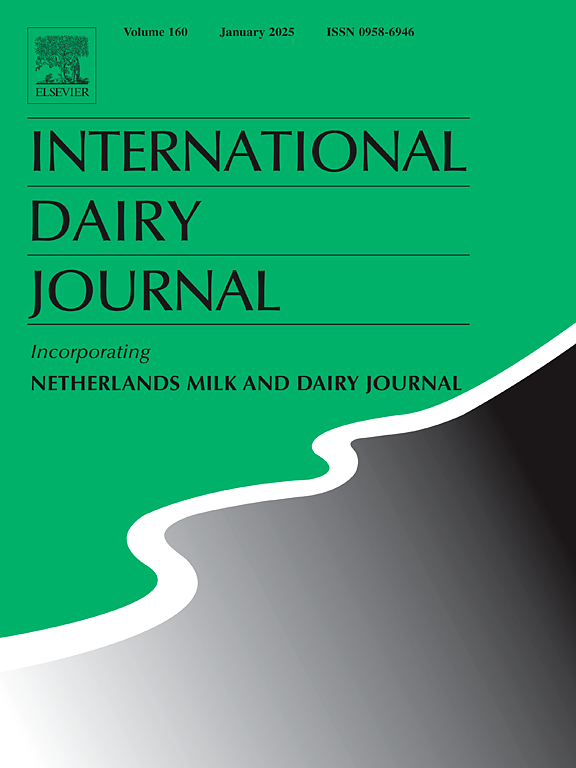Antimicrobial, antioxidant and anticancer properties of bioactive bacteriocins produced by Lactococcus hircilactis CH4 and Lactobacillus delbrueckii GRIPUMSK isolated from homemade fermented dairy products
IF 3.4
3区 农林科学
Q2 FOOD SCIENCE & TECHNOLOGY
引用次数: 0
Abstract
Lactic acid bacteria (LAB) are known to produce bacteriocins. In this work, two lactic acid bacterial strains, Lactococcus hircilactis CH4 and Lactobacillus delbrueckii GRIPUMSK were isolated from fermented dairy products. They were tested for their antimicrobial, antioxidant, and anticancer properties. This research aimed to isolate bioactive bacteriocins from these two LAB strains under various conditions and thoroughly examined their molecular structure and physico-chemical properties. The optimal culture conditions for bacteriocin production such as time, temperature, pH, and carbon and nitrogen source supplementation were analyzed. The molecular weight of bacteriocins from Lb. delbrueckii GRIPUMSK and Lc. hircilactis CH4 were detected with the size of 23.8 and 8.9 kDa, respectively. The Fourier transform infrared (FTIR) spectrum of both the bacteriocins from LAB showed, –OH/N-H stretching vibrations, amide II groups and C-N stretch respectively. Proton nuclear magnetic resonance (1H NMR) spectrum of both the bacteriocins from LAB revealed seven and nine amino acids respectively. The extracted bacteriocins were revealing that bacteriocins from both strains exhibit heat resistance and stability across a wide range of detergents, organic solvents, and pH levels compared to nisin. Furthermore, we discovered that these bacteriocins effectively inhibited (89.00 ± 1.12 % and 86.00 ± 0.67 %) Helicobacter pylori biofilm formation at 100 μg/mL, demonstrated antioxidant capabilities, and showed enhanced selective cytotoxicity with IC50 at 29.87 and 42.52 μg/ml against human colon cancer cells (HT-29). In conclusion, the two isolated bacteriocins serve as safe postbiotic materials in the food and pharmaceutical industries, offering potential benefits to treat cancer and its associated bacterial infections synergistically.
自制发酵乳制品中hircilactilactococcus CH4和delbrueckilactobacillus GRIPUMSK产生的生物活性菌素的抗菌、抗氧化和抗癌特性
众所周知,乳酸菌(LAB)会产生细菌素。本研究从发酵乳制品中分离到了两株乳酸菌:hircilactilactococcus CH4和delbrueckii Lactobacillus GRIPUMSK。测试了它们的抗菌、抗氧化和抗癌特性。本研究旨在从这两株LAB菌株中分离出不同条件下的生物活性菌素,并对其分子结构和理化性质进行深入研究。分析了时间、温度、pH、添加碳氮源等培养条件对细菌素产量的影响。比较了delbrueckii、grpumsk和Lc中细菌素的分子量。检测到hircilactis CH4,大小分别为23.8和8.9 kDa。两种细菌素的傅里叶变换红外(FTIR)光谱分别显示-OH /N-H拉伸振动,酰胺II基团和C-N拉伸振动。两种细菌素的质子核磁共振(1H NMR)谱分别显示了7个和9个氨基酸。提取的细菌素表明,与nisin相比,这两种菌株的细菌素在各种洗涤剂、有机溶剂和pH值下都表现出耐热性和稳定性。此外,我们发现这些细菌素在100 μg/mL时有效抑制幽门螺杆菌生物膜的形成(89.00±1.12%和86.00±0.67%),具有抗氧化能力,并表现出增强的选择性细胞毒性,对人结肠癌细胞(hl -29)的IC50分别为29.87和42.52 μg/mL。总之,这两种分离的细菌素在食品和制药工业中作为安全的后生物材料,为协同治疗癌症及其相关细菌感染提供了潜在的益处。
本文章由计算机程序翻译,如有差异,请以英文原文为准。
求助全文
约1分钟内获得全文
求助全文
来源期刊

International Dairy Journal
工程技术-食品科技
CiteScore
6.50
自引率
9.70%
发文量
200
审稿时长
49 days
期刊介绍:
The International Dairy Journal publishes significant advancements in dairy science and technology in the form of research articles and critical reviews that are of relevance to the broader international dairy community. Within this scope, research on the science and technology of milk and dairy products and the nutritional and health aspects of dairy foods are included; the journal pays particular attention to applied research and its interface with the dairy industry.
The journal''s coverage includes the following, where directly applicable to dairy science and technology:
• Chemistry and physico-chemical properties of milk constituents
• Microbiology, food safety, enzymology, biotechnology
• Processing and engineering
• Emulsion science, food structure, and texture
• Raw material quality and effect on relevant products
• Flavour and off-flavour development
• Technological functionality and applications of dairy ingredients
• Sensory and consumer sciences
• Nutrition and substantiation of human health implications of milk components or dairy products
International Dairy Journal does not publish papers related to milk production, animal health and other aspects of on-farm milk production unless there is a clear relationship to dairy technology, human health or final product quality.
 求助内容:
求助内容: 应助结果提醒方式:
应助结果提醒方式:


